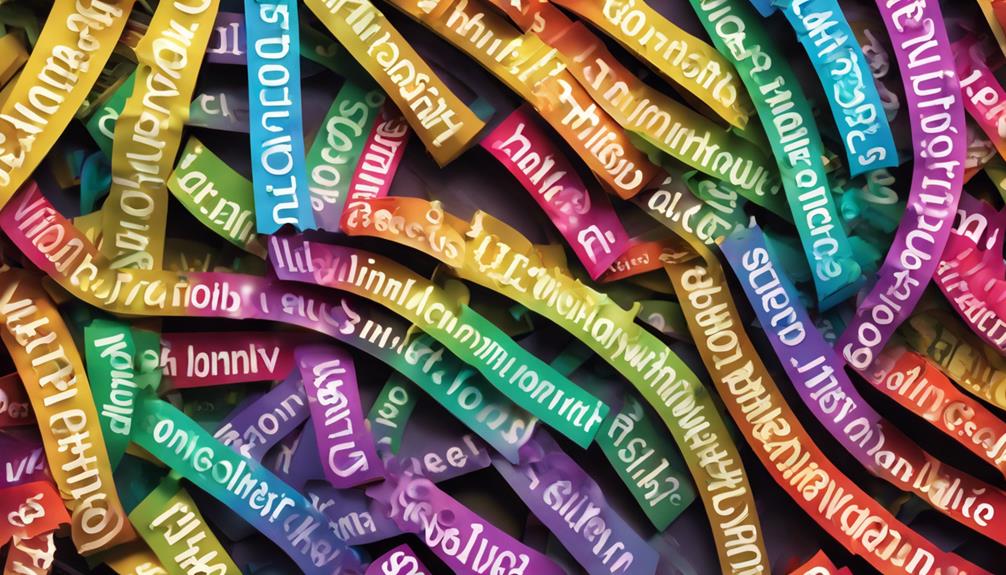Figurative language elevates text by adding layers of meaning beyond the literal. Metaphors, similes, personification, and hyperbole are tools that bring words alive. Metaphors directly compare, similes use 'like' or 'as,' and personification attributes human traits to objects. Hyperbole exaggerates for emphasis. Metaphors spark imagination and deep understanding. Personification gives depth by animating the inanimate. Hyperbole intensifies while staying memorable. Alliteration adds musicality and amplifies emotions. Figurative language enhances communication, connecting with readers on a profound level. Its intricate web enriches the written word, making writing more engaging and impactful. Further insights await beyond this overview.
Key Takeaways
- Figurative language uses metaphors, similes, personification, and hyperbole to convey deeper meanings.
- It enhances communication by creating vivid images, evoking emotions, and adding depth to writing.
- Metaphors compare unlike things, similes use 'like' or 'as', personification gives life to objects, and hyperbole exaggerates.
- Figurative language goes beyond literal meanings to spark imagination and connect with readers on an emotional level.
- Understanding figurative language types and their functions enriches writing and aids in effective communication.
Definition of Figurative Language
Figurative language, as we explore its intricacies, reveals a treasure trove of expressive techniques that transcend literal meanings. In the domain of language, figurative language stands as a beacon of creativity and depth. It goes beyond the mere conveyance of information, delving into the world of emotions and imagination. Metaphors, similes, personification, hyperbole – these are the tools of the trade for any wordsmith aiming to paint vivid landscapes in the minds of their audience. By employing comparisons, exaggerations, and attributing human characteristics to inanimate objects, figurative language breathes life into narratives, making them not just stories but experiences.
Understanding figurative language is akin to cracking a secret code within literature. It allows us to appreciate the subtle nuances woven into the fabric of written works. Through this lens, we can analyze the deeper layers of meaning, unravel the complexities of emotions, and savor the beauty of crafted words. Mastering figurative language opens the door to a world where words dance beyond their literal definitions, inviting readers to join in the grand spectacle of storytelling.
Importance of Figurative Language

Figurative language enriches our writing, allowing us to convey complex ideas in a more engaging and imaginative way. It connects with readers on a deeper level, evoking emotions and creating vivid mental images that enhance the overall reading experience.
Enhancing Communication Depth
Exploring the depth of communication is illuminated by the profound impact of figurative language in conveying intricate emotions and ideas. When delving into the domain of figurative language, we encounter a myriad of ways it enriches our communication:
- Metaphors paint vivid pictures in the mind, bridging abstract concepts with tangible images.
- Similes offer comparisons that highlight similarities or differences, aiding in clarity and emphasis.
- Personification breathes life into inanimate objects, infusing them with human characteristics and emotions.
- Hyperbole exaggerates for effect, intensifying the message and leaving a lasting impression.
Evoking Emotional Connections
Enhancing communication depth through the use of figurative language illuminates the emotional connections it evokes, bringing non-living things to life with human traits and resonating deeply with readers. When used effectively, figurative language creates a bridge between the abstract and the emotional, allowing readers to connect on a personal level. By infusing inanimate objects with human characteristics, writers can evoke empathy, nostalgia, or even humor, making their writing more relatable and engaging. Through the clever use of similes, metaphors, and personification, figurative language adds layers of meaning to storytelling, enriching the reader's experience and leaving a lasting impression. This emotional resonance is what makes figurative language such a powerful tool in the hands of skilled writers.
| Emotional Connection | Impact on Readers |
|---|---|
| Evokes empathy | Engages imagination |
| Creates nostalgia | Enhances relatability |
| Adds humor | Leaves lasting impression |
Types of Figurative Language

Understanding the various types of figurative language can greatly enhance one's ability to communicate creatively and effectively. When we use figurative language, we paint vivid pictures in the minds of our audience, making our messages more engaging and memorable. Here are some key types of figurative language to master:
- Simile: Comparing two unlike things using 'like' or 'as' to create vivid imagery.
- Metaphor: Directly comparing two unlike things without 'like' or 'as' for deeper meanings.
- Personification: Giving human characteristics to non-living objects for engaging narratives.
- Hyperbole: Using exaggeration to emphasize a point and intensify impact.
Role of Metaphors in Figurative Language

Metaphors play an essential role in figurative language by enhancing communication, sparking imagination, and creating vivid imagery.
They allow us to convey complex ideas in a more engaging and accessible way, making writing more compelling and thought-provoking.
Through metaphors, we can paint pictures with words and evoke deeper emotions and connections in our audience.
Metaphors Enhance Communication
Comparing two dissimilar entities through metaphors in figurative language allows for a more engaging and relatable conveyance of complex ideas. For example, describing a challenging problem as a “mountain to climb” helps individuals visualize the effort and persistence required to overcome it. This creative expression not only simplifies abstract concepts but also makes the message more vivid and memorable. However, it’s important to note the difference between figurative language and diction; while figurative language involves imaginative comparisons, diction refers to the specific word choices that shape the tone and clarity of the message. Understanding figurative language and diction differences is crucial for both clarity and emotional resonance in communication. While figurative language enriches a narrative by offering depth and creativity, careful diction ensures that the intended meaning is conveyed without ambiguity. Together, these elements work in harmony to engage readers and evoke stronger emotional responses, making complex ideas more accessible and impactful.
Metaphors are like bridges, connecting unfamiliar territories of thought. They act as windows, letting light into the darkest corners of understanding.
Metaphors serve as keys, opening doors to new perspectives and insights. They're the colors on a canvas, painting vivid pictures in the mind's eye.
By infusing language with metaphors, we transform mere words into living, breathing concepts that resonate with depth and meaning.
Metaphors not only enhance communication but also enrich our cognitive experience, making the abstract tangible and the intricate comprehensible.
Metaphors Spark Imagination
Sparkling with creativity, metaphors in figurative language ignite the fires of imagination, illuminating uncharted territories of thought. By bridging the gap between the familiar and the unfamiliar, metaphors offer a fresh perspective that goes beyond the confines of literal language.
They serve as powerful tools to engage the mind, inviting readers to explore new ideas and emotions through imaginative comparisons. Additionally, metaphors have the ability to inject a sense of humor into communication, adding an element of playfulness and levity to the narrative.
Through the clever use of metaphors, writers can captivate their audience, encouraging them to see the world in a different light and fostering a deeper connection between the text and the reader.
Metaphors Create Vivid Imagery
As we explore the role of metaphors in figurative language, we uncover their remarkable ability to paint vibrant pictures in the minds of readers through direct comparisons of disparate elements.
Metaphors are used to:
- Compare the fierce storm to a raging beast, evoking a sense of power and unpredictability.
- Describe a broken heart as shattered glass, conveying the fragility and pain of emotional hurt.
- Portray time as a flowing river, symbolizing its continuous motion and unstoppable nature.
- Depict love as a blossoming flower, capturing the idea of growth, beauty, and nurturing relationships.
These vivid comparisons enhance the descriptive quality of writing, evoke emotions, and help convey abstract ideas more concretely. Metaphors are commonly used in literature and everyday language to add depth and richness to expressions.
Exploring Similes in Figurative Language

Exploring the domain of figurative language reveals a world where vivid imagery is crafted through the comparison of unlike elements using words like 'like' or 'as'. Similes play a vital role in enhancing our understanding of complex ideas by drawing parallels between unrelated concepts. They not only help readers visualize scenarios but also add depth and creativity to writing, making descriptions more engaging and memorable. By using similes, writers can evoke a wide range of emotions and create powerful mental images that readers can easily connect with.
Understanding similes is key to mastering literary analysis and appreciation. By recognizing the nuanced comparisons within texts, readers can investigate deeper into the layers of meaning embedded in the words. Similes serve as bridges between the known and the unknown, guiding us through the intricate tapestry of language and imagination. Mastering the art of crafting and interpreting similes opens the door to a world of enriched communication and storytelling.
Personification in Figurative Language

Personification in figurative language brings inanimate objects and abstract concepts to life by attributing human qualities to them, enhancing the depth and engagement of literary works. When we personify elements in writing, we breathe life into them, allowing the reader or listener to connect with the words on a deeper level. This literary device paints vivid pictures in the audience's mind, making the narrative more relatable and gripping. Here is how personification works its magic:
- Objects come alive: Describing a tree dancing in the wind creates a visual spectacle.
- Nature speaks: The roaring thunderstorm gives voice to the elements of nature.
- Emotions in motion: The howling wind mirrors the emotions of a turbulent soul.
- Abstract concepts take shape: Love knocking on the door personifies an intangible feeling.
Through personification, writers can evoke emotions, establish connections, and craft compelling stories that resonate with the audience.
Impact of Hyperbole in Figurative Language

Moving from the vivid imagery brought to life by personification, hyperbole in figurative language takes exaggeration to extreme levels to amplify statements and create lasting impressions. Hyperbole involves using extravagant and exaggerated words to emphasize a point or create a vivid image in the reader's mind. By stretching the truth beyond reality, hyperbole adds a dramatic effect to the words, making them more impactful and memorable.
| Impact of Hyperbole in Figurative Language |
|---|
| Facts about Hyperbole |
| – Involves extreme exaggeration |
| – Amplifies intensity beyond literal truth |
| – Creates vivid and memorable imagery |
| – Common in everyday language and literature |
Writers strategically use hyperbole to evoke strong emotions, add humor, or emphasize specific aspects of a situation. By intentionally overstating certain words or phrases, hyperbole captures the audience's attention and leaves a lasting impression. Through the artful use of hyperbole, writers can effectively convey the depth of their words and engage readers in a powerful and compelling manner.
Alliteration and Figurative Language

Exploring the dynamic interplay between alliteration and figurative language enhances the rhythmic and aesthetic qualities of written and spoken expressions. Alliteration, a language that utilizes the repetition of initial consonant sounds, can have a profound impact on the overall tone and mood of a piece. When utilized effectively, it can create a harmonious flow and make the text more engaging for the reader or listener.
Here are some key points to ponder:
- Alliteration adds emphasis to specific words or phrases, drawing attention to them in a subtle yet impactful manner.
- It contributes to the musicality of language, making the text more pleasing to the ear and enhancing its overall aesthetic appeal.
- Alliteration can amplify the emotions conveyed in a piece, intensifying the impact of the message being communicated.
- Understanding the role of alliteration in figurative language can aid in analyzing the stylistic choices made by writers and poets, leading to a deeper appreciation of their work.
Frequently Asked Questions
How Do You Use Figurative Language?
We use figurative language by creatively employing techniques like simile, metaphor, personification, hyperbole, and alliteration to convey deeper meanings and evoke emotions in our writing.
By utilizing these tools, we can make our writing more engaging and vivid, painting pictures in the reader's mind that go beyond literal interpretations.
Incorporating figurative language allows us to create impactful descriptions that resonate with our audience and enhance storytelling.
How Do You Determine Figurative Language?
When determining figurative language, we look for words or phrases that go beyond their literal meaning. Keep an eye out for comparisons using words like 'like' or 'as' for similes, direct comparisons for metaphors, human qualities given to non-human objects for personification, exaggerated statements intensifying images for hyperbole, and repeated initial sounds for alliteration.
These elements enhance the text by adding depth and creativity to the language used.
What Effect Does Figurative Language Have on the Reader?
Figurative language affects us in profound ways by crafting vivid mental images and stirring our emotions. It cultivates a deeper connection to the text, making complex concepts more relatable through creative comparisons.
Enriching writing with depth and complexity, it enhances the reading experience and embeds stories in our memories. By sparking our imagination, figurative language draws us into the narrative, making it more engaging and immersive.
How Are Figurative Devices Used?
Figurative devices like similes and metaphors create comparisons to enhance imagery and convey deeper meanings in writing. Personification attributes human qualities to non-human entities, making them more relatable and engaging for readers. Hyperboles use exaggeration for emphasis, adding dramatic effect and intensity to descriptions.
Alliteration repeats initial sounds to create rhythm and enhance the musical quality of language in writing. Figurative language works by stimulating readers' imagination, emotions, and senses to create a more immersive and impactful reading experience.
Conclusion
As we wrap up our exploration of figurative language, we can see how these literary devices add depth and creativity to our communication. Just like a well-crafted metaphor can paint a vivid picture in our minds, figurative language helps us express complex ideas in a more engaging and memorable way.
By incorporating similes, personification, hyperbole, and alliteration into our writing, we can create a powerful impact on our audience, leaving a lasting impression that resonates long after the words have been read.











